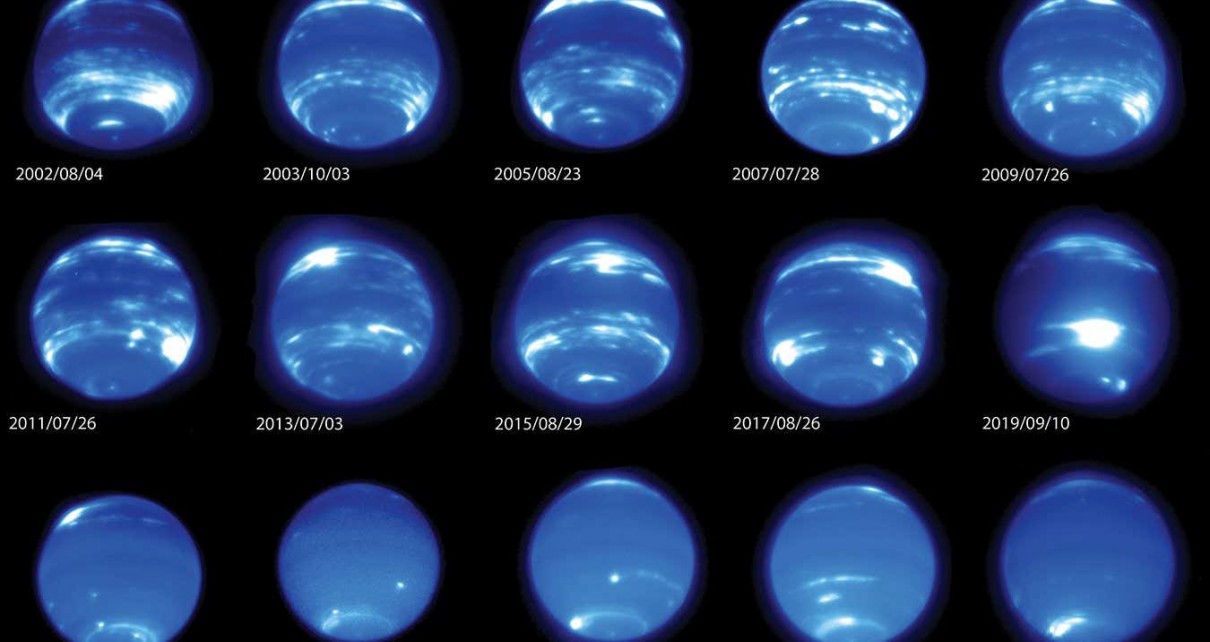[ad_1]

Changes in cloud cover on Neptune from 2002 to 2023
Imke de Pater, Erandi Chavez, Erin Redwing (UC Berkeley)/W. M. Keck Observatory
Neptune’s clouds have disappeared. Since the first detailed images of the planet were taken by the Voyager 2 spacecraft in 1989, its cerulean disc has been criss-crossed by wispy white clouds, but its skies are now almost completely clear. Astronomers think that the abundance of clouds on Neptune might be governed by the sun’s 11-year cycle, despite the planet being extremely distant from the sun.
Erandi Chavez at the University of California, Berkeley, and her colleagues tracked the cloud activity on Neptune from 1994 to 2022. They examined archival images from two ground-based astronomical observatories and the Hubble space telescope. The researchers found that the amount of cloud cover fluctuated regularly, with particularly cloudy conditions in 2002 and 2015, and particularly clear ones in 2007 and 2020.
The dip in cloud cover in 2020 was the lowest ever observed – Neptune as a whole was the darkest we have ever seen it, without any white clouds to reflect sunlight. “Even now… the most recent images we took this past June still show the clouds haven’t returned to their former levels,” said Chavez in a statement. “Neptune’s previous period of low cloud activity was not nearly as dramatic and prolonged.”
The changes also happened unexpectedly rapidly, particularly during 2019. “I was surprised by how quickly clouds disappeared on Neptune,” said Imke de Pater, also at the University of California, Berkeley, and part of the team. “We essentially saw cloud activity drop within a few months.”
The pattern seems to roughly match up with the sun’s 11-year cycle of activity, albeit with a two-year lag between the sun’s extremes and Neptune’s. It seems that when the sun is most active, more clouds begin to form on Neptune, and when it is least active, Neptune’s clouds dissipate.
This most likely occurs because when sunlight hits the top of Neptune’s atmosphere, its energy could kick-start chemical reactions there, creating clouds of methane and other chemicals. Those chemical reactions take time, hence the two-year delay. The correlation is surprising, though, because Neptune is so far from the sun that it only gets 1 per cent the sunlight that Earth does – from there, the sun looks more like a particularly bright star in the night sky than the blinding orb that we see from Earth.
The correlation isn’t completely confirmed yet. While sunlight could certainly cause the reactions that create Neptune’s clouds, it could also darken the clouds and hazes, so the cause and effect may not be quite so simple.
Also, Neptune occasionally has huge storms that begin deep in its atmosphere and then rise to the surface, and it is unclear what role that might play. The researchers are continuing to monitor Neptune to try to get a better grip on the complexities of its cloud layers.
Topics:
[ad_2]
Source link




